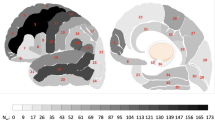Abstract.
The responsiveness or excitability of the central nervous system (CNS) to external or internal stimuli is systematically altered corresponding to transient changes of the EEG background activity, mainly in the alpha range. We hypothesise that a transient alpha power increase is due to an underlying increase in synchronisation or coupling strength between various neuronal elements or cortical networks. Consequently, the `network' of the CNS may be more ordered and, hence, less complex in the case of high spectral density, and vice versa. The goals of the present paper are (1) to prove the inverse covariation between spectral density and correlation dimension for a set of human EEG data, (2) to falsify the null hypothesis that the observed relationship is a random one, and (3) to propose a neuronal approach which may explain the observed correlations. A sliding computation of the spectral density and correlation dimension [Grassberger P, Procaccia I (1983) Physica D 9:189–208] of mid-occipital EEG recordings derived from eight awake subjects with eyes closed was performed. The similarity between the two time courses was quantified by similarity measures and descriptive correlation coefficients. The temporal pattern of dimensional complexity showed an inverse relationship with simultaneously computed spectral power changes most pronounced in the alpha range. The group means of similarity measures and correlation coefficients were compared with the corresponding means of a sample set established by 20 Gaussian random signals. Statistically significant differences were obtained at the 0.1% level, rejecting the null hypothesis that the observed relationship is a random one. The results support the idea that the dynamics of the EEG signals investigated reflect a chaotic deterministic process with state transitions from `high-dimensional' to `low-dimensional' non-linear dynamics, and vice versa. Adequate neuronal models and approaches to interpret the disclosed transients and the inverse covariation between spectral density and dimensional complexity are proposed, giving additional insight into the integrative functioning of the CNS with respect to the strategy of information processing.
Similar content being viewed by others
Author information
Authors and Affiliations
Additional information
Received: 15 December 1998 / Accepted in revised form: 18 May 1999
Rights and permissions
About this article
Cite this article
Tirsch, W., Keidel, M., Perz, S. et al. Inverse covariation of spectral density and correlation dimension in cyclic EEG dynamics of the human brain. Biol Cybern 82, 1–14 (2000). https://doi.org/10.1007/PL00007957
Issue Date:
DOI: https://doi.org/10.1007/PL00007957




